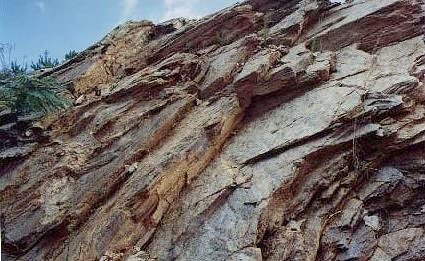As we’ve said before, all telescopes really want to be in space. In part 3 of our series on amateur telescope making, we bring you up to speed on the final frontier: amateurs building space telescopes. The hardware and software is available off the shelf, and launches have never been more affordable. The era of amateur space telescopes has arrived.
Continue reading “Astronomy Cast Ep. 329: Telescope Making, Part 3: Space Telescopes”
Astro-Challenge: Nabbing Venus… at Inferior Conjunction
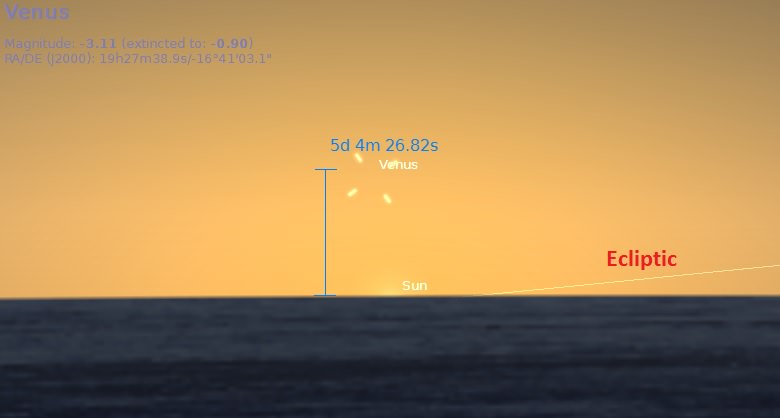
Residents of high northern latitudes can take heart this frigid January: this coming weekend offers a chance to replicate a unique astronomical sighting.
Veteran sky watcher Bob King recently wrote a post for Universe Today describing what observers can expect from the planet Venus for the last few weeks of this current evening apparition leading up to Venus’s passage between the Earth and the Sun on January 11th. Like so many other readers, we’ve been holding a nightly vigil to see when the last date will be that we can spot the fleeing world… and some great pics have been pouring in.
But did you know that when the conditions are just right, that you can actually spy Venus at the moment of inferior conjunction?
No, we’re not talking about a rare transit of Venus as last occurred on June 6th, 2012, when Venus crossed the disk of the Sun as seen from our Earthly perspective… you’ll have to wait until 2117 to see that occur again. What we’re talking about is a passage of Venus high above or below the solar disk, when spying it while the Sun sits just below the horizon might just be possible.
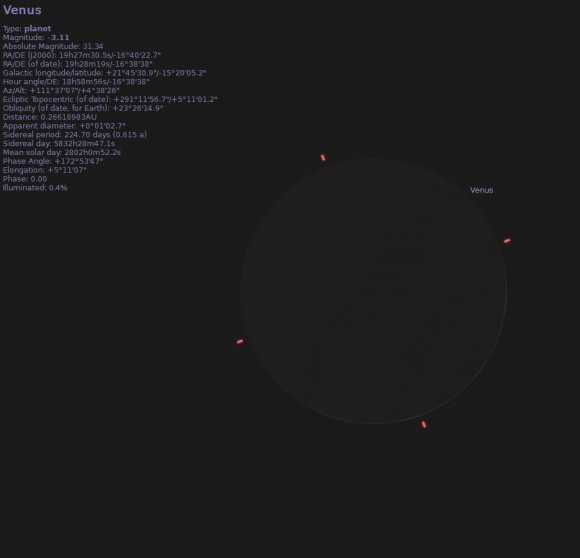
Not all inferior conjunctions of Venus are created equal. The planet’s orbit is tilted 3 degrees with respect to our own and can thus pass a maximum of eight degrees north or south of the Sun. Venus last did this on inferior conjunction in 2009 and will once again pass a maximum distance north of the Sun in 2017. For the southern hemisphere, the red letter years are 2007, and next year in 2015.
You’ll note that the above periods mark out an 8-year cycle, a period after which a roughly similar apparition of the planet Venus repeats. This is because Venus takes just over 224 days to complete one orbit, and 13 orbits of Venus very nearly equals 8 Earth years.
And while said northern maximum is still three years away, this week’s inferior conjunction is close at five degrees from the solar limb. The best prospects to see Venus at or near inferior conjunction occur for observers “North of the 60”. We accomplished this feat two Venusian 8-year cycles ago during the inferior conjunction of January 16th, 1998 from latitude 65 degrees north just outside of Fairbanks, Alaska. We set up on the Chena Flood Channel, assuring as low and as flat a horizon as possible… and we kept the engine of our trusty Jeep Wrangler idling as a refuge from the -40 degrees Celsius temperatures!
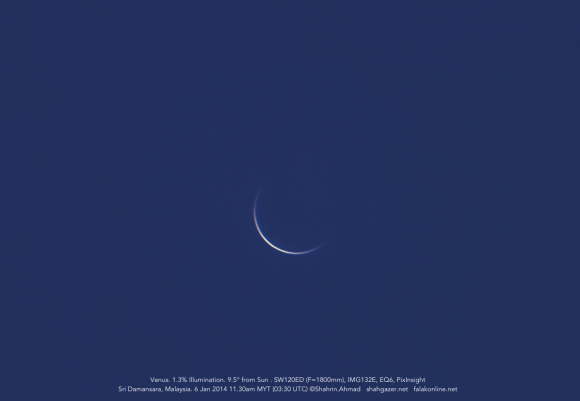
It took us several frigid minutes of sweeping the horizon with binoculars before we could pick up the dusky dot of Venus through the low atmospheric murk and pervasive ice fog. We could just glimpse Venus unaided afterward, once we knew exactly where to look!
This works because the ecliptic is at a relatively shallow enough angle to the horizon as seen from the high Arctic that Venus gets its maximum ~five degree “boost” above the horizon.
A word of warning is also in order not to attempt this sighting while the dazzling (and potentially eye damaging) Sun is above the horizon. Start sweeping the horizon for Venus about 30 minutes before local sunrise, with the limb of the Sun safely below the horizon.
Venus presents a disk 1’ 02” across as seen from Earth during inferior conjunction, the largest of any planet and the only one that can appear larger than an arc minute in size. Ironically, both Venus and Earth reach perihelion this month. Said disk is, however, only 0.4% illuminated and very near the theoretical edge of visibility known as the Danjon Limit. And although the technical visual magnitude of Venus at inferior conjunction is listed as -3.1, expect that illumination scattered across that razor thin crescent to be more like magnitude -0.6 due to atmospheric extinction.
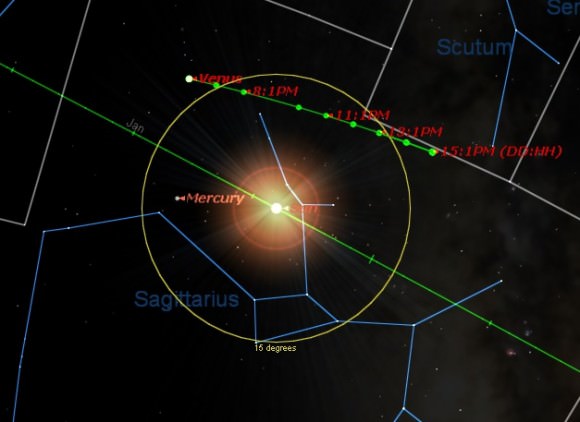
Are you one of the +99% of the world’s citizens that doesn’t live in the high Arctic? You can still watch the passage of Venus from the relative warmth of your home online, via the Solar Heliospheric Observatory’s (SOHO) vantage point in space. SOHO sits at the sunward L1 point between the Earth and the Sun and has been monitoring Sol with a battery on instruments ever since its launch in 1995. A great side benefit of this is that SOHO also catches sight of planets and the occasional comet that strays near the Sun in its LASCO C2 and C3 cameras. Venus will begin entering the 15 degree wide field of view for SOHO’s LASCO C3 camera on January 7th, and you’ll be able to trace it all the way back out until January 14th.
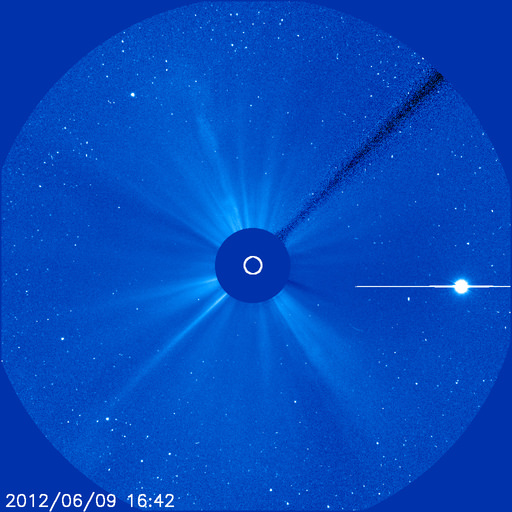
From there on out, Venus will enter the early morning sky. When is the first date that you can catch it from your latitude with binoculars and /or the naked eye? Venus spends most of the remainder of 2014 in the dawn, reaching greatest elongation 46.6 degrees west of the Sun on March 22nd, 2014 and is headed back towards superior conjunction on the farside of the Sun on October 25th, 2014. But there’s lots more Venusian action in 2014 in store…. more to come!
Global Warming Explained in 52 Seconds
We are awash in the unseen, the unknown and the unexplained. Our Universe is enshrouded in mystery. Even what we do know — the complex physical laws that describe the planets, stars and galaxies — can seem just beyond any normal human being’s grasp. We can’t all be Einsteins, after all.
But excluding string theory, dark energy and quantum field theory most of science is remarkably within our grasp. And in less than a minute, a concept as culturally conflicted and misunderstood as global warming, can be explained. See above.
The motivation behind this video is simple. Research shows that virtually no Americans — roughly 0 percent — can explain the physical mechanisms of global warming at even a basic level. So Berkeley Professor Michael Ranney and colleagues created a total of five videos (with the longest clocking in at 656 words in under five minutes) with the hope of elucidating the basics of global warming.
Their initial study, completed in 2011, surveyed 270 people in San Diego parks in order to assess how well the average American understands global warming. San Diego was chosen because it draws tourists from across the United States, and would thus create a better rounded sample.
“The main concept we were hoping people would tell us, which is at the heart of understanding global warming, is that there is an asymmetry between stuff that’s coming in to our planet and stuff that’s heading out,” Ranney told Universe Today.
This asymmetry explains why sunlight (in the form of visible light) may enter the atmosphere unhindered but is later impeded by greenhouse gases (because it is no longer in the form of visible light — it has been absorbed by the Earth and emitted in the form of infrared light). But not a single person could explain global warming at this basic level.
“We were shocked at how few people knew this” Ranney said. “I thought it was a moral imperative to get the word out as fast as possible.”
So Ranney and his colleagues set out with their work in front of them, creating the videos in order to increase the average American’s understanding of global warming. Their goal is that any one of the five videos will change the lives of seven billion viewers.
“We hope that a video of 400 words or even 35 words will allow people to have a moment in time to which they fix that they knew what the mechanism of climate change was,” Ranney told Universe Today. For that single moment “their knowledge was obvious, valid, understandable and available.”
In order to drive this point home, Ranney used an analogy that began like this: “So a climate change acceptor walks into a bar.” But all jokes aside, if one who accepts anthropogenic global warming tries to convince the man sitting next to him that global warming is real, but cannot explain the physical mechanism behind global warming, then he’s in trouble. He’s likely not only lost his bar mate but encouraged a life-time of global warming denial.
We cannot expect to increase the public’s awareness and acceptance of climate change without a huge increase in scientific literacy. Even if every viewer can’t recall the exact mechanistic details of global warming they can at least say to the man sitting next to them at the bar: “Look, I can’t regurgitate it now but I did understand it then.”
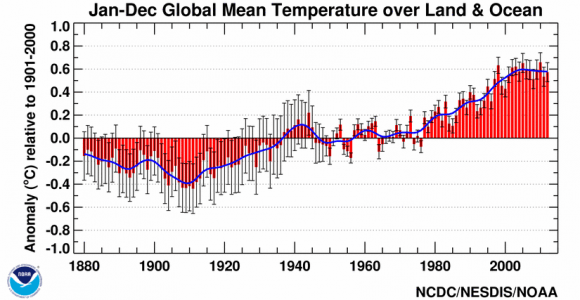
A second study provided college students with an explanation akin to the one found in the five-minute video. After reading it, the students not only understood global warming better but they were also more likely to accept global warming as a reality — suggesting these videos have the power to change people’s minds.
“Eventually people come to appreciate salient evidence,” Ranney told Universe Today. “Let’s say you think you’re in a fantastic monogamous relationship. If you come home and find your partner with someone else, it only takes that one moment in time to change your belief.”
Helping people to understand the basic physics behind global warming is a vital tool in convincing them that global warming is as real as it gets. Once someone clicks on the video, the next 52 seconds alone might leave a pretty big impact.
You can view all the videos on howglobalwarmingworks.org.
Ranney emphasized help from graduate student Lee Nevo Lamprey, undergraduate student Kimberly Le and other collaborators (including Dav Clark, Daniel Reinholz, Lloyd Goldwasser, Sarah Cohen and Rachel Ranney).
Will The Sun Explode?
All stars die, some more violently than others.
Once our own Sun has consumed all the hydrogen fuel in its core, it too will reach the end of its life. Astronomers estimate this to be a short 7 billion years from now. For a few million years, it will expand into a red giant, puffing away its outer layers. Then it’ll collapse down into a white dwarf and slowly cool down to the background temperature of the Universe.
I’m sure you know that some other stars explode when they die. They also run out of fuel in their core, but instead of becoming a red giant, they detonate in a fraction of a second as a supernova.
So, what’s the big difference between stars like our Sun and the stars that can explode as supernovae?
Mass. That’s it.
Supernova progenitors – these stars capable of becoming supernovae – are extremely massive, at least 8 to 12 times the mass of our Sun. When a star this big runs out of fuel, its core collapses. In a fraction of a second, material falls inward to creating an extremely dense neutron star or even a black hole. This process releases an enormous amount of energy, which we see as a supernova.
If a star has even more mass, beyond 140 times the mass of the Sun, it explodes completely and nothing remains at all. If these other stars can detonate like this, is it possible for our Sun to explode?
Could there be some chain reaction we could set off, some exotic element a rare comet could introduce on impact, or a science fiction doomsday ray we could fire up to make the Sun explode?
Nope, quite simply, it just doesn’t have enough mass. The only way this could ever happen is if it was much, much more massive, bringing it to that lower supernovae limit.
In other words, you would need to crash an equally massive star into our Sun. And then do it again, and again.. and again… another half dozen more times. Then, and only then would you have an object massive enough to detonate as a supernova.
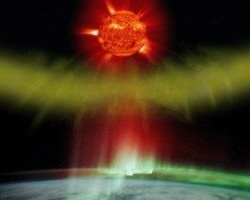
Now, I’m sure you’re all resting easy knowing that solar detonation is near the bottom of the planetary annihilation list. I’ve got even better news. Not only will this never happen to the Sun, but there are no large stars close enough to cause us any damage if they did explode.
A supernova would need to go off within a distance of 100 light-years to irradiate our planet.
According to Dr. Phil Plait from Bad Astronomy, the closest star that could detonate as a supernova is the 10 solar mass Spica, at a distance of 260 light-years. No where near close enough to cause us any danger.
So don’t worry about our Sun exploding or another nearby star going supernova and wiping us out. You can put your feet up and relax, as it’s just not going to happen.
Virtual Star Party – January 5, 2014: Jupiter in Opposition and 6 Telescopes!
Hosts: Fraser Cain and Scott Lewis
Astronomers:
David Dickinson in Florida
Michael Phillips in North Carolina
Bill McLaughlin in Oregon
Gary Gonella in California
Paul Stewart in New Zealand
Shahrin Ahmad in Malaysia
Stuart Foreman in San Francisco
Thad Szabo in California
Continue reading “Virtual Star Party – January 5, 2014: Jupiter in Opposition and 6 Telescopes!”
Spirit Retrospective: Top Shots on 10th Year Since Mars Touchdown
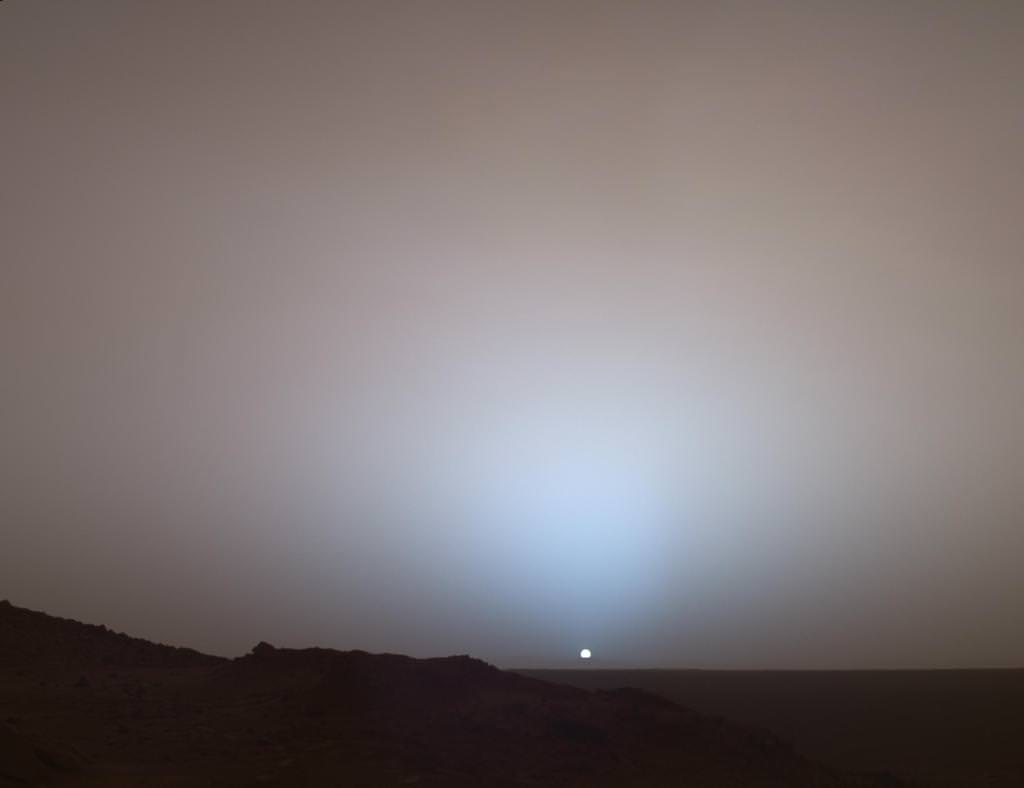
A Moment Frozen in Time
On May 19th, 2005, NASA’s Mars Exploration Rover Spirit captured this stunning view as the Sun sank below the rim of Gusev crater on Mars. This Panoramic Camera (Pancam) mosaic was taken around 6:07 in the evening of Sol 489. The terrain in the foreground is the rock outcrop “Jibsheet,” a feature that Spirit has been investigating for several weeks (rover tracks are dimly visible leading up to “Jibsheet”). The floor of Gusev crater is visible in the distance, and the Sun is setting behind the wall of Gusev some 80 km (50 miles) in the distance.
Credit: NASA/JPL-Caltech/Texas A&M/Cornell
See photo gallery below[/caption]
Today it’s hard to imagine a Mars without Spirit.
But a decade ago, NASA’s six wheeled Spirit rover was but a promise of great things to come. And her rich Martian scientific heritage we know today was but a dream yet to ensue
Jan. 3 marks the 10th anniversary since her touchdown on Mars on Jan. 3, 2004. Her twin sister Opportunity soft landed 3 weeks later on Jan. 24, 2004.
So here’s a collection of some of Spirit’s greatest hits on the Red Planet for all to enjoy and remember her fabulous exploits.
Read my detailed new overview marking ‘Spirits 10 Years on Mars’ – here – with even more spectacular Red Planet imagery!
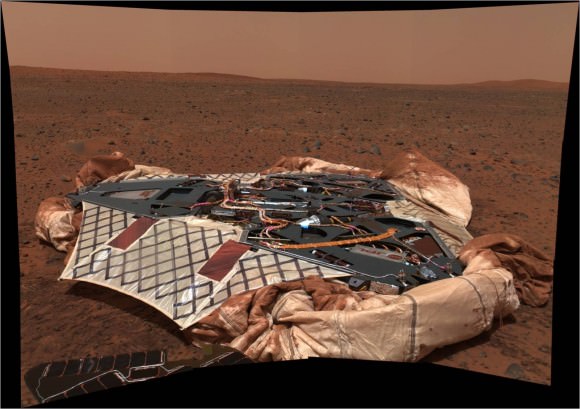
Since the golf cart sized Spirit snapped over 128,000 raw images, drove 4.8 miles and ground into 15 rock targets we can’t show everything.
Here’s a retrospective of some of our favorites.
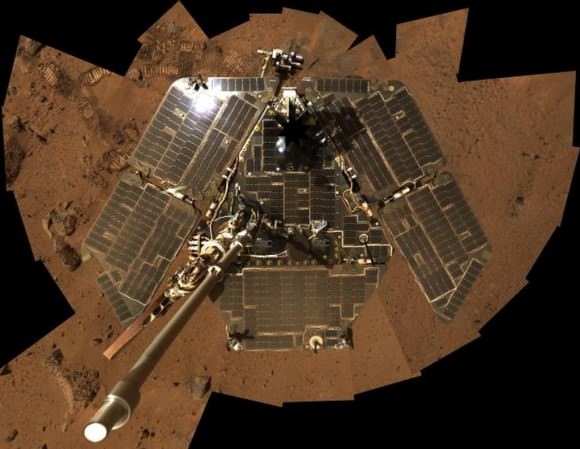
During her more than six year lifetime spanning until March 2010, Spirit discovered compelling evidence that ancient Mars exhibited hydrothermal activity, hot springs and volcanic explosions flowing with water.
“Spirit’s big scientific accomplishments are the silica deposits at Home Plate, the carbonates at Comanche, and all the evidence for hydrothermal systems and explosive volcanism, Rover Principal Investigator Steve Squyres of Cornell University, explained to me in an earlier interview.
“What we’ve learned is that early Mars at Spirit’s site was a hot, violent place, with hot springs, steam vents, and volcanic explosions. It was extraordinarily different from the Mars of today.”
Meanwhile, NASA’s new Curiosity rover just celebrated 500 Sols on Mars and is speeding towards Mount Sharp from inside Gale Crater – which is about the same size as Gusev crater.
Stay tuned here for Ken’s continuing Mars rover, Curiosity, Chang’e-3, SpaceX, Orbital Sciences, LADEE, MAVEN, MOM and more news.
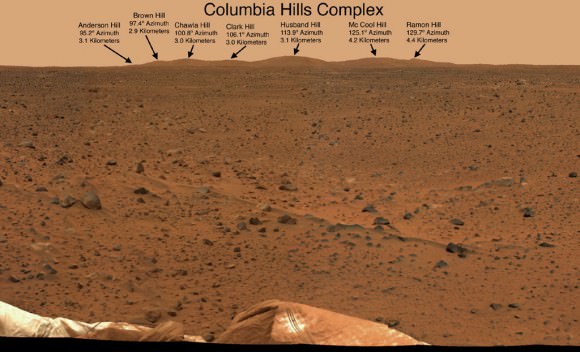

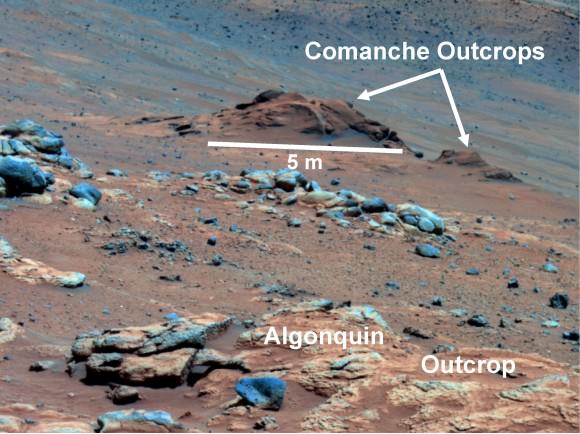

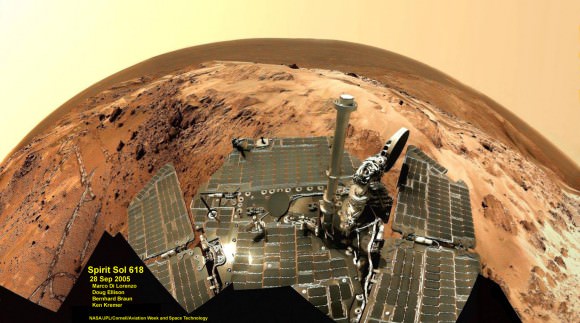

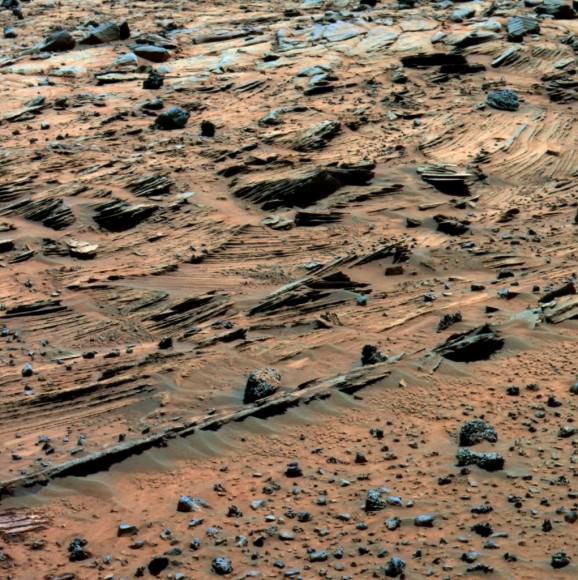
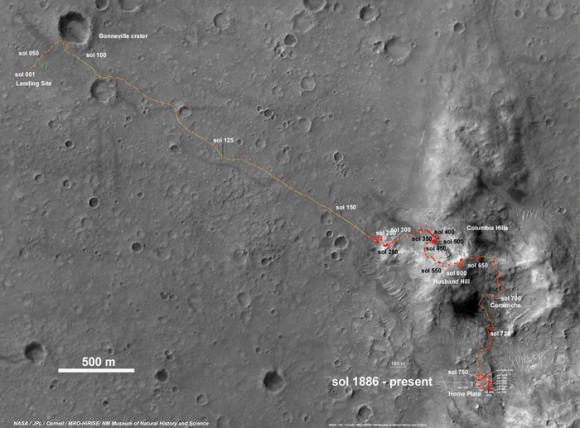
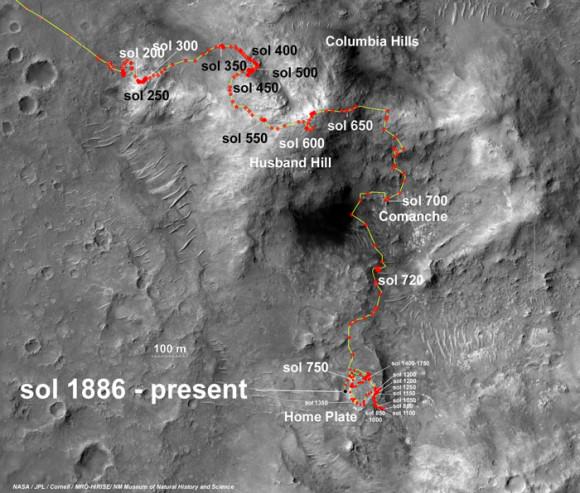
Spirit Rover Landed on Mars 10 Years Ago Today
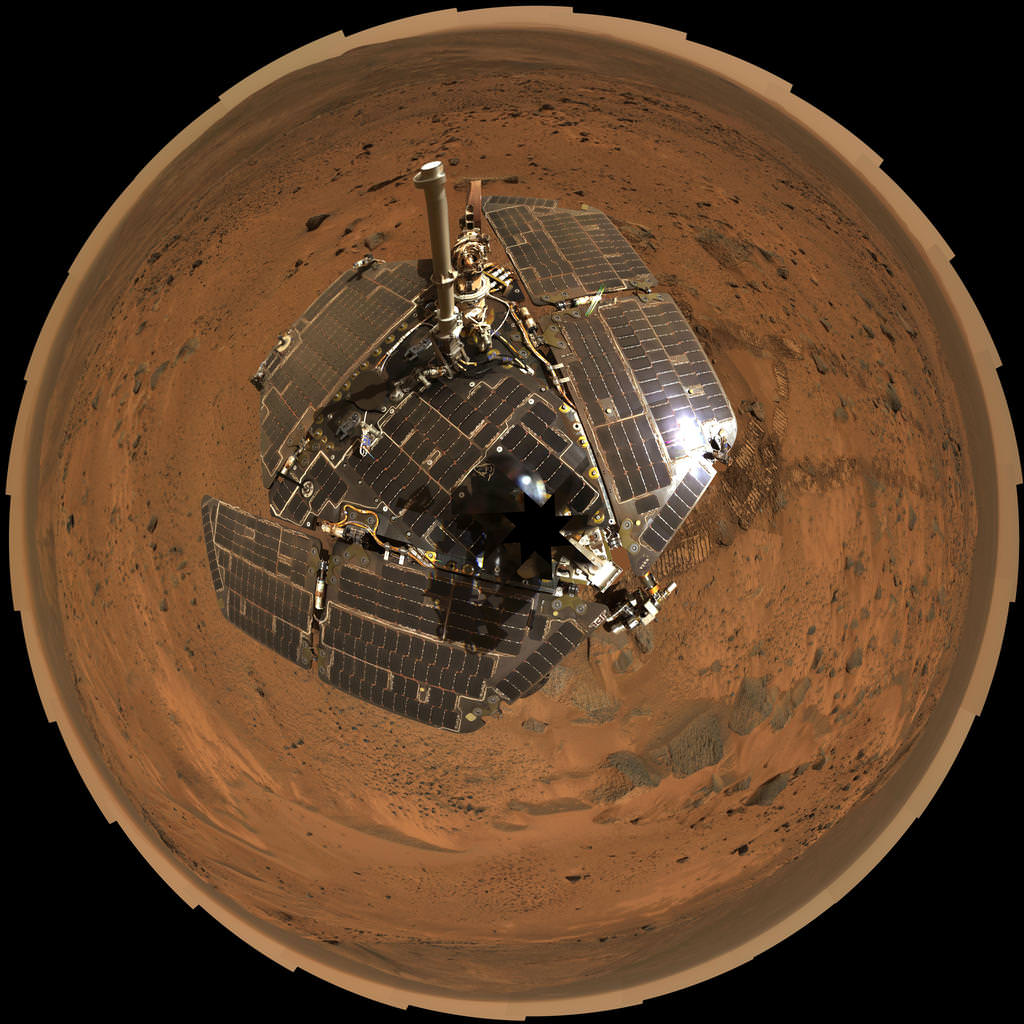
Ten Years Ago, Spirit Rover Lands on Mars
This bird’s-eye view from August 2005 combines a self-portrait of the spacecraft deck and a panoramic mosaic of the Martian surface as viewed by NASA’s Mars Exploration Rover Spirit. The rover’s solar panels are still gleaming in the sunlight, having acquired only a thin veneer of dust two years after the rover landed and commenced exploring the red planet. Spirit captured this 360-degree panorama on the summit of “Husband Hill” inside Mars’ Gusev Crater. During the period from Spirit’s Martian days, or sols, 583 to 586 (Aug. 24 to 27, 2005), the rover’s panoramic camera acquired the hundreds of individual frames for this largest panorama ever photographed by Spirit. Credit: NASA/JPL-Caltech/Cornell
See Spirit’s 1st and last panoramas and more imagery below[/caption]
Today, Jan. 3, marks the 10th anniversary since the safe landing of NASA’s renowned Spirit rover on the plains of Mars on Jan. 3, 2004.
Spirit comprises one half of NASA’s now legendary pair of Mars Exploration Rovers (MER). Opportunity, her twin sister landed, on the opposite side of the Red Planet three weeks later – on Jan. 24, 2004. The goal was to “follow the water” as a potential enabler for past Martian microbes if they ever existed.
Together, the long-lived, golf cart sized robots proved that early Mars was warm and wet, billions of years ago – a key finding in the search for habitats conducive to life beyond Earth.
Exactly a decade ago, the famous robot survived the scorching atmospheric heating of the 6 minute plunge through the thin Martian atmosphere, bounced some two dozen times cocooned inside cushioning airbags, and gradually rolled to a stop inside 100 mile wide Gusev Crater. It was known as the “6 minutes of Terror”.
The three petaled landing pad opened and Spirit was dramatically born in a milestone event that will be forever remembered in the annuls of history because of the groundbreaking scientific discoveries that ensued and the unbelievable longevity of the twins.

This mosaic image taken on Jan. 4, 2004, by the navigation camera on the Mars Exploration Rover Spirit, shows a 360 degree panoramic view of the rover on the surface of Mars. Spirit operated for more than six years after landing in January 2004 for what was planned as a three-month mission. Credit: NASA/JPL
Before they were launched atop Delta II rockets in the summer of 2003 from Cape Canaveral, the dynamic, solar powered robo duo were expected to last a mere three months – with a ‘warranty’ of 90 Martian days (Sols).
Either dust accumulation on the life giving solar panels, an engineering issue or the extremely harsh Martian environment was expected to somehow terminate them mercilessly.
In reality, both robots enormously exceeded expectations and accumulated a vast bonus time of exploration and discovery in numerous extended mission phases.

This beautiful scene reveals a tremendous amount of detail in Spirit’s surroundings at a place called “Winter Haven,” where the rover spent many months parked on a north-facing slope in order to keep its solar panels pointed toward the sun for the winter. During this time, it captured several images to create this high resolution panorama. During that time, while the rover spent the daylight hours conducting as much scientific research as possible, science team members assigned informal names to rock outcrops, boulders, and patches of soil commemorating exploration sites in Antarctica and the southernmost islands of South America. Antarctic bases are places where researchers, like the rovers on Mars, hunker down for the winter in subzero temperatures. During the past Martian winter, Spirit endured temperatures lower than minus 100 degrees Celsius (minus 148 degrees Fahrenheit). Credit: NASA/JPL/Cornell
No one foresaw that Martian winds would occasionally clean the solar panels to give them a new lease on life or that the components would miraculously continue functioning.
Spirit endured the utterly extreme Red Planet climate for more than six years until communications ceased in 2010.
Opportunity is still roving Mars today, and doing so in rather good condition!
Altogether, Spirit drove 4.8 miles (7.73 kilometers),that’s about 12 times more than the original goal set for the mission.
She transmitted over 128,000 images.
After landing in the dusty plains, she headed for the nearby Columbia Hills some 2 miles away and ultimately became the first Martian mountaineer, when she scaled Husband Hill and found evidence for the flow of liquid water at the Hillary outcrop.
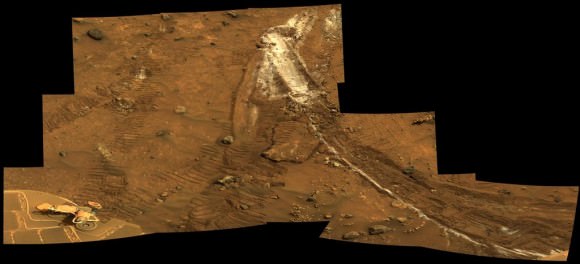
The rovers were not designed to climb hills. But eventually she scaled 30 degree inclines.
The rover was equipped with a rock grinder named the Rock Abrasion Tool (RAT) built by Honeybee Robotics.
Spirit ground the surfaces off 15 rock targets and scoured 92 targets with a brush to prepare the targets for inspection with spectrometers and a microscopic imager, according to NASA.
Eventually she drove back down the hill and made even greater scientific discoveries in the area known as ‘Home Plate’.
Spirit survived three harsh Martian winters and only succumbed to the Antarctic-like temperatures when she unexpectedly became mired in an unseen sand trap driving beside an ancient volcanic feature named ‘Home Plate’ that prevented the solar arrays from generating life giving power to safeguard critical electronic and computer components.
In 2007, Spirit made one of the key discoveries of the mission at ‘Home Plate’ when her stuck right front wheel churned up a trench of bright Martian soil that exposed a patch of nearly pure silica, which was formed in a watery hot spring or volcanic environment.
Spirit was heading towards another pair of volcanic objects named ‘von Braun’ and ‘Goddard’ and came within just a few hundred feet when she died in the sand trap.
See Spirits last panorama below – created from raw images taken in Feb. 2010 by Marco Di Lorenzo and Ken Kremer.
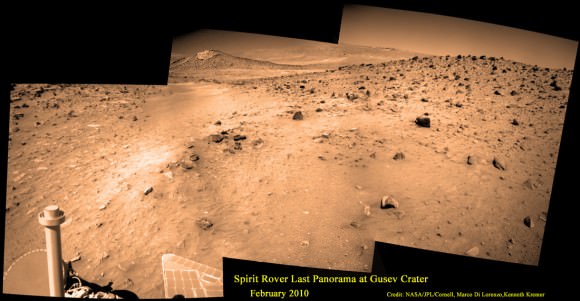
Spirit’s last panorama from Gusev Crater was taken during February 2010 before her death from extremely low temperatures during her 4th Martian winter. Spirit was just 500 feet from her next science target – dubbed Von Braun – at center, with Columbia Hills as backdrop. Mosaic Credit: Marco Di Lorenzo/ Kenneth Kremer/ NASA/JPL/Cornell University. Mosaic featured on Astronomy Picture of the Day (APOD) on 30 May 2011 – http://apod.nasa.gov/apod/ap110530.html
Here’s how the rovers’ principal investigator, Steve Squyres of Cornell University, Ithaca, N.Y., described some of the key findings in a NASA statement, starting with what Spirit found after driving from the crater floor where it landed into the Columbia hills to the east:
“In the Columbia Hills, we discovered compelling evidence of an ancient Mars that was a hot, wet, violent place, with volcanic explosions, hydrothermal activity, steam vents — nothing like Mars today.
“At Opportunity’s landing site, we found evidence of an early Mars that had acidic groundwater that sometimes reached the surface and evaporated away, leaving salts behind. It was an environment with liquid water, but very different from the environment that Spirit told us about.
“When Opportunity got to the rim of Endeavour Crater, we began a whole new mission. We found gypsum veins and a rich concentration of clay minerals. The clay minerals tell us about water chemistry that was neutral, instead of acidic — more favorable for microbial life, if any ever began on Mars.”
“Because of the rovers’ longevity, we essentially got four different landing sites for the price of two.”
Meanwhile, NASA’s new Curiosity rover just celebrated 500 Sols on Mars and is speeding towards Mount Sharp from inside Gale Crater – which is about the same size as Gusev crater.
And a pair of newly launched orbiters are streaking to the Red Planet; NASA’s MAVEN and India’s MOM.
And China’s new Yutu lunar rover and Chang’e-3 lander are napping through the lunar night until mid-January.
Stay tuned here for Ken’s continuing Curiosity, Chang’e-3, SpaceX, Orbital Sciences, LADEE, MAVEN, Mars rover and MOM news.
…………….
Learn more about Curiosity, MAVEN, MOM, Mars rovers, SpaceX, Orbital Sciences Antares Jan. 8 launch, and more at Ken’s upcoming presentations
Jan 6-8: “Antares/Cygnus ISS Rocket Launch from Virginia on Jan. 8” & “Space mission updates”; Rodeway Inn, Chincoteague, VA, evening
This Town Celebrates Every New Year with a Falling Meteor
Video from YouTube User Pam Bergmann
The popular jazz tune “Stars Fell on Alabama” was inspired in part by the Leonid meteor shower in November of 1833, sometimes referred to as “the night the stars fell.” But the central region of Alabama region has a history of meteorite impacts, including a massive impact over 84 million years ago. The town of Wetumpka, Alabama sits in the middle of an ancient 8-kilometer-wide impact crater that was blasted into the bedrock, creating the unique geology of what is now Elmore County.
To celebrate this “striking” heritage, Wetumpka celebrates every New Year’s Eve with a spectacular recreation of a falling, exploding meteor.
Geologists have pieced together the events from millions years ago, when an asteroid nearly the size of a football stadium crashed into what was at the time a coastal basin covered with a shallow sea. The jumbled and disturbed geology of the area hadn’t made sense to local geologists since they started studying it in the 1800’s, and they had no explanations until mapping in the early 1970’s showed that the rocky layers were pointing away from a central location, which led them to suspect some sort of large impact.
However, this location wasn’t verified as an impact crater until fairly recently, when core samples drilled in 1998 confirmed the impact by detecting the presence of shocked quartz. The Wetumpka Impact Crater was officially recognized in 2002, and is now considered to be the best preserved marine impact crater ever discovered.

And so, in honor of this history, the folks of Wetumpka have been ringing in the new year by having their own ‘meteor’ streak across the sky and drop to the ground, guided by a wire and followed by fireworks. This event has been recognized as one of the top 10 unique New Year’s Celebrations in the U.S. by TripAdvisor.
You can see the preparation for the event at WSFA 12’s story here.
For more information regarding the crater, visit these sites:
Wetumpka Impact Crater Commission
Wetumpka Meteor Crater Tour by the Auburn Astronomical Society
Wetumpka Impact Crater Page
Also, I was born in Wetumpka, so Happy New Year!
Weekly Space Hangout – January 3, 2014: Quadrantids & What’s Coming in 2014
Host: Fraser Cain
Guests: Emily Lakdawalla, David Dickinson, Jason Major, Brian Koberlein, Brian Wang
Continue reading “Weekly Space Hangout – January 3, 2014: Quadrantids & What’s Coming in 2014”
Ultra-Thin “Young” Crescent Moon Sighted from U.S. Southwest
Earlier this week, Universe Today challenged North American readers to spot the slender, exceptionally “young” crescent Moon on the evening of New Year’s Day.
Three visual athletes based in Arizona took up the challenge on Wednesday evening, with amazing results. Mike Weasner, Rob Sparks and Jim Cadien managed to spot the razor thin crescent Moon just 13 hours and 48 minutes after it passed New phase earlier on January 1st. The sighting was made using binoculars, and they even managed to image the wisp of a crescent hanging against the desert sky.
This is a difficult feat, even under the best of conditions. Weasner and Sparks observed from Mike’s Cassiopeia observatory based just outside of Oracle, Arizona.
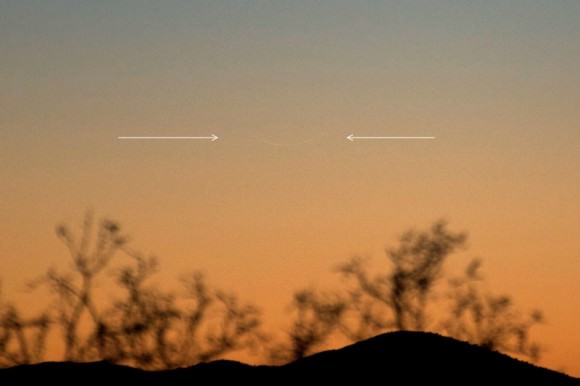
Concerning the feat, Weasner wrote on his observing blog:
“At 1800 Mountain Standard Time (MST), Rob reported that he had located the young Moon using his 8×42 binoculars. At 18:02 MST, I picked it up in the 12×70 binoculars. With the New Moon occurring at 11:14 Universal Time (UT), my observation occurred with the Moon only 13 hours and 48 minutes old. A new record for me (and Rob and Jim as well). Our DSLRs were clicking away!”
We can personally attest to just how hard it is to pick out the uber-thin crescent Moon against the twilight sky. Low contrast is your enemy, making it tough to spot and even tougher to photograph. Add to that a changing twilight sky that alters hue from moment to moment.
Though this isn’t a world record, its close to within about two hours. The youngest confirmed Moon spotting using binoculars stands at 11 hours and 40 minutes accomplished by Mohsen G. Mirsaeed in Iran back in September 7th, 2002, and the youngest Moon sighted with the unaided eye goes to Steven James O’Meara in May 1990, who spotted a 15 hour 32 minute old crescent.
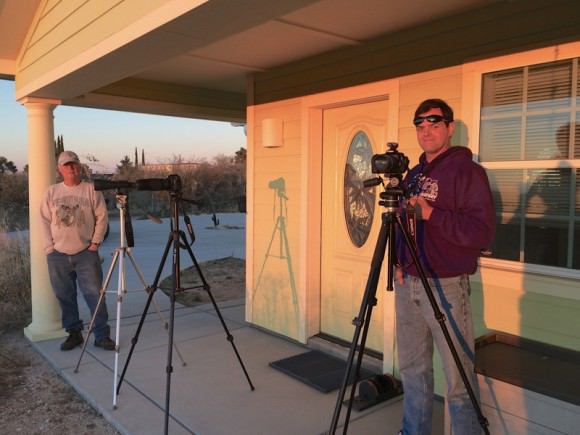
And of course, you can see the Moon at the moment of New during a a solar eclipse. Unfortunately, no total solar eclipses occur in 2014, just an usual non-central annular eclipse brushing Australia and Antarctica on April 29th and a deep 81% partial eclipse crossing North America on October 23rd.
Weasner also noted that a bright Venus aided them in their quest. It’s strange to think that Venus, though visually tiny, is actually intrinsically brighter than the limb of the Moon, owing to its higher albedo. In fact, some great pictures have also been pouring in to Universe Today of Venus as it heads towards inferior conjunction this month on January 11th. And don’t forget, that quoted magnitude of the lunar crescent (about magnitude -3.4) was also scattered along the lunar disk which was only 0.4% illuminated, and subject to atmospheric extinction to boot!
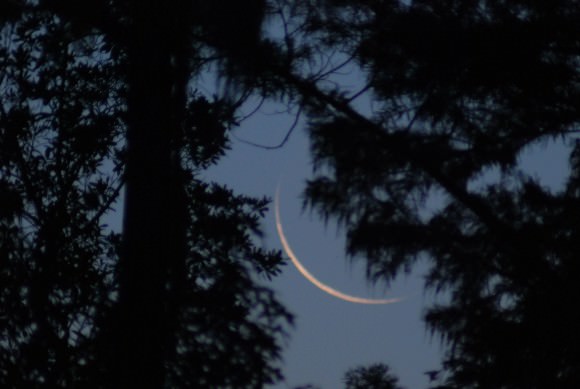
And yes, it is possible to catch the Moon photographically during a non-eclipse at the moment of New phase. The Moon can wander up to 5 degrees – about ten times its average apparent diameter as seen from the Earth – above or below the ecliptic and appear a corresponding distance from the limb of the Sun. Unlike many moons in the solar system, Earth’s moon has a fixed inclination to our orbit (as traced out by the ecliptic,) not our rotational axis. Thierry Legault accomplished this challenging photographic feat last year. Of course, this should only be attempted by seasoned astrophotographers, as aiming a camera near the Sun is not advised.
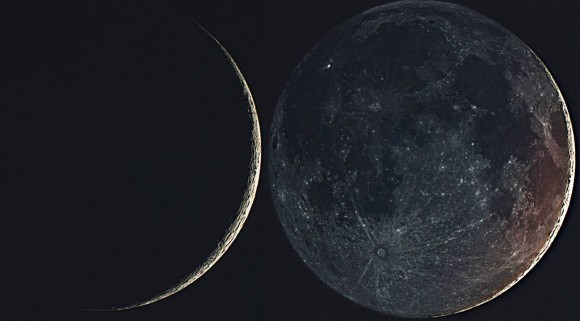
Why attempt to spot the razor thin New Moon? What’s the benefit? Well, several lunar based dating systems, such as the Islamic calendar, rely on the spotting of the new crescent Moon to mark the beginning of a new month. Being strictly lunar-based, the Islamic calendar moves an average of -11 days out of sync each year versus the modern day Gregorian calendar. On some years, there can even be a bit of ambiguity as to exactly when key months such as Ramadan will begin based on when the Moon is first sighted.
Also, such a feat demonstrates what the human eye is capable of when pushed to its physiological limits. In fact, French astrophysicist Andre Danjon theorized that the lunar crescent is formed at about 5 degrees elongation from the Sun, a point beyond which a lunar crescent can be sighted — usually quoted at about 7 degrees elongation from the Sun — and has become known as the Danjon Limit. Danjon also gave his namesake to the characterization of total lunar eclipses by color and hue, known as the Danjon Number. Accounting for the motion of the Moon, this places the theoretical limit that the forming crescent can be sighted with optical assistance at just over 11 hours.
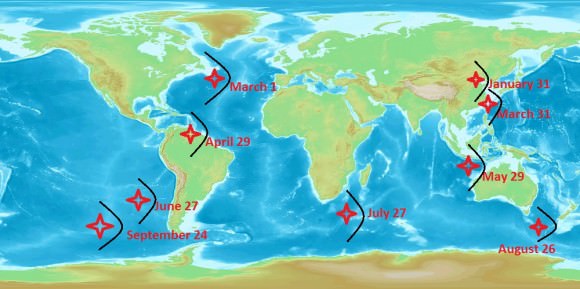
And you don’t have to wait until the Moon passes New… a similar attempt can be made in the dawn skies as the waning crescent Moon slides towards the Sun at the end of each lunation.
But perhaps the true reward is simply catching a glimpse of the ethereal for yourself, a delicate and airy Moon clinging briefly on the horizon. Kudos to Mike and Rob on a great catch!
Follow the further adventures of Mike Weasner and Rob Sparks on Twitter as @mweasner & @halfastro.
Wonder what the sighting opportunities are for the next waxing crescent Moon are worldwide? Two great online resources are the HM Nautical Office’s Einstein Moonwatch Project and Moonsighting.com.
The South African Astronomical Observatory also maintains a site with predictions worldwide.



![MER10-SpiritAndOpportunity_ByTheNumbers[1]](https://www.universetoday.com/wp-content/uploads/2014/01/MER10-SpiritAndOpportunity_ByTheNumbers1-580x423.jpg)
